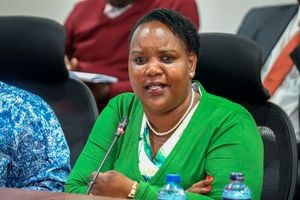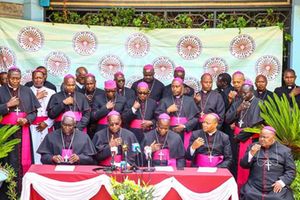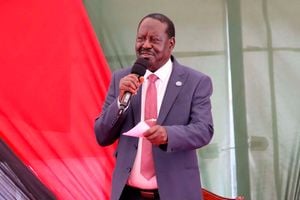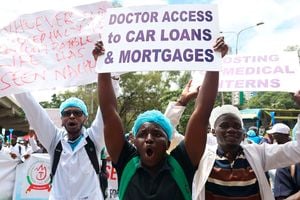
The doctors’ strike, now in its 31st day, is one in a series of since 1982.
As hundreds of doctors stormed Ministry of Health offices in Nairobi on Monday, Cabinet Secretary Susan Nakhumicha remained silent.
The Sunday Nation went to her office on the same day to find out what was being done to end the stalemate in negotiations and suffering of Kenyans.
Ms Nakhumicha declined to speak to us for the one and a half hours we camped at the office. Her aide, however, was willing to talk.
The aide said the CS was in a “top-priority” virtual meeting on a different but pressing issue. We could, however, see her seven floors above peeping through window to get a glimpse of the striking healthworkers.

Hundreds of health workers participate in a demonstration in Nairobi on April 9, 2024.
How did past ministers handle such crises?
Kenya’s first health minister Njoroge Mungai (1963-64), his successor Joseph Otiende (1964-69), Isaac Okero (1970-74) and James Osogo (1975-79) never experienced a doctors’ strike.
Arthur Magugu
Kenya’s first ever doctors’ strike was when Arthur Magugu was the Minister of Health in 1982. There was a crisis following resignations by doctors and specialist consultants from public service.
That was because of a decree by President Daniel arap Moi that required doctors to work for the government on full-time basis.
Moi argued that divided loyalties by doctors compromised services.
“I don’t want to lead a nation of mercenaries. They must serve the nation wholeheartedly,” Moi said, according to the Kenya YearBook.
Magugu had to deal with mass resignations, resulting in disruption of services at public hospitals and training of medical students.
In private, Magugu would call union leaders for talks but put on a brave face in public, saying services had not been disrupted.
He later explored a return-to-work formula when President Moi relaxed his stance on the matter.
Mukasa Mango
The deal that was struck after the strike would see Mr Magugu’s successor at the ministry, Apollinary Mukasa Mango (1982-84) have few problems with doctors.
His tenure, however, was not without controversy. Mango began to question the awarding of some tenders at the ministry, to the chagrin of influential procurement networks.
President Moi transferred him to the Cooperative Development docket following a Cabinet reshuffle in September 1983.
Peter Nyakiamo
Peter Otieno Nyakiamo, a banker, was in charge at the Health Ministry from 1985 to 1987. The teetotaller is on record saying he had a good time at Afya House because of a solid dependable team.
Kenneth Matiba
Kenneth Matiba became Kenya's first minister to resign from President Daniel arap Moi's cabinet in 1988, after the 1988 Mlolongo elections. He headed the Ministry of Health for a year. He had been a member of parliament since 1983.
Mwai Kibaki
In 1988, President Moi named Mwai Kibaki the Health Minister, a post he held until 1991. His tenure was largely devoid of strikes and protests.
Kibaki resigned from the Cabinet and ruling party Kanu to launch the Democratic Party following the introduction of pluralism.
Joshua Angatia
Joshua Angatia was the Kenya’s second Health Minister (1991-94) to deal with a doctors’ strike. Doctors were pressing for registration of the Kenya Medical Practitioners and Dentists Union (KMPDU). The government rejected the idea, saying doctors were providers of essential services.
“You can go on strike for a year, but the union will not be registered,” Angatia told doctors.
The leaders of the strike were dismisses or deregistered. Some fled the country while others left government service.
Angatia is famous for confessing his helplessness and in fact coined the phrase “Mafia House” to refer to the ministry headquarters .
Jackson Mulinge
President Moi brought in a military man, Gen (rtd) Jackson Mulinge – “Man of Steel” – to the ministry from 1994 to 1997. He sought to disengage Mulinge from the military and introduce him to politics. The aim was to use the general to neutralise Paul Ngei’s influence in Eastern Province. Mulinge had a smooth and orderly tenure.
Amukowa Anangwe
For the time Amukowa Anangwe was at the helm of the ministry from 1999 to 2000, Afya House thrived.
Prof Anangwe is remembered for the role he played in forming a task force to explore ways of reducing drug prices. He consulted and had doctors and their union leaders by his side.
The task force comprised representatives from the ministry, the WHO, the UN, Kenya Medical Association, the Pharmaceutical Society of Kenya, the Federation of Kenya Pharmaceutical Manufacturers, Medecins Sans Frontieres, Treasury and the University of Nairobi’s Department of Pharmacy.
High producer or importer prices, strong patent protection, tariffs and taxes and high wholesale and retail mark-ups were blamed for the skyrocketing prices.
Prof Anangwe said a drug like fluconazole for treating HIV/Aids-related meningitis, cost US30 cents per 200mg capsule for the generic version in Thailand compared to $18 in Kenya, where it was patent-protected.
Five pharmaceutical firms reduced the cost of HIV/Aids drugs as a result. Some media reports indicated that Kenya was negotiating for up to 85 per cent reduction in the prices of the drugs.
The drugs remained expensive until late 2000s when the government started supplying antiretrovirals for free.
The ministry would later “have issues” with a tender for supply of ambulances to hospitals under the National Hospital Insurance Fund. This led to his departure.
Sam Ongeri
Close friends of Prof Sam Ongeri describe him as a man who never wanted to be involved in fights.
In a 2000 Cabinet reshuffle, the Delhi University-trained doctor was moved to the Health Ministry from Local Government.
Hussein Maalim
Prof Ongeri was succeeded by Hussein Maalim Mohammed. In December 2002, Kibaki took over as President, naming Charity Ngilu the Minister of Health.
Charity Ngilu
Ms Ngilu led the ministry until 2007. During her tenure, a 2005 nationwide civil servants strike left patients in agony. She issued a memo to departmental heads to submit daily reports of absentee workers.
The formating of the coalition government after the disputed 2007 elections saw the ministry split into two.
These were the Ministry of Medical Services under Prof Anyang Nyong’o and the Ministry of Public Health and Sanitation under Ms Beth Mugo, both serving from 2008 to 2013.
Anyang Nyong’o
Prof Anyang Nyong’o complained that splitting the ministry had led to overlaps in responsibilities. He submitted a proposal to the President saying the two deliver results effectively and more affordably as one docket. The idea was rejected.
Beth Mugo
When a doctors’ strike crippled the healthcare system in October 2009, Ms Mugo took the lead in diffusing it. She brought in medical students, military nurses and volunteer cooks to fill in for protesters.
Eight people died at KNH as a result of the strike. Ms Mugo said doctors and KNH management would be arraigned for the deaths. The doctors were demanding their pay increased six times.
James Macharia
Mr Macharia was named CS by then-President Uhuru Kenyatta and served from 2013 and 2015.
A weeklong strike by doctors in December 2013 was over the moving of healthcare management from the national government to counties.
The doctors wanted the national government to be in charge of human resource management until a Health Service Commission is put in place.
Mr Macharia also agreed with governors, saying the forming such a commission would be a against devolution. He added that health was a devolved function.
Cleopa Mailu
Dr Mailu served as Health Cabinet Secretary from 2015 to 2017. During his tenure, Kenya’s deadliest and most strike by doctors paralysed the healthcare system. The work boycott lasted 100 days.
The more than 5,000 doctors began their strike on December 5, 2016. Their main grievance was pay, with the union demanding a 180 per cent salary increase.
An 40 per cent offer by the government was rejected. In the offer, medical interns would earn a minimum of Sh196,989 and the highest earning doctors would receive Sh542, 954 a month.
After much back and forth, the doctors signed a pay deal in 2017. Those in the lowest job group C3 would get a minimum monthly pay of Sh206,989 and maximum of Sh218,954.
Those in the highest job group E2 would receive Sh531,085 to Sh562, 954 every month.
The agreement also stated that interns would be posted within 30 days and work for 40 hours a week.
Dr Mailu said the government was open to negotiations but doctors risked missing pay for boycotting work.
“Paying someone who has not been working for 30 days is an audit query,” he said.
The strike had terrible impacts, with dozens of patients dying. The ministry estimated that 500,000 children were not vaccinated against some of the world’s most debilitating diseases, including polio, pneumonia, meningitis, measles, influenza and hepatitis.
Sicily Kariuki
Ms Kariuki took over from Dr Mailu and served from 2018 to 2020. There was no major doctor strike during the period. The only time she had to deal with grievances was during the importation of Cuban doctors. KPMDU rejected the decision, saying local doctors should have been hired instead as many were qualified.
Mutahi Kagwe
Mr Kagwe became Health CS in 2020 when the world began battling the Covid-19 pandemic. As doctors struggled to treat those with the virus, they also lost colleagues to the disease.
That was one of the reasons they joined nurses and clinical officers in a strike in December 2020. It was after the death of Dr Stephen Mogusu, who until his last breath was dealing with coronavirus patients at Machakos Level Five Hospital.
Doctors said he had died as a result of failure by the government to supply protective gear to healthworkers.
Mr Kagwe maintained the strike was illegal and that doctors risked being dismissed. He said the government had provided enough protective gear.
Another grievance by the medics was shortage of doctors to deal with the huge number of coronavirus patients. They wanted more doctors hired and those who had not been paid to receive their full salaries. An intervention by Mr Kenyatta saw the doctors resume work.











